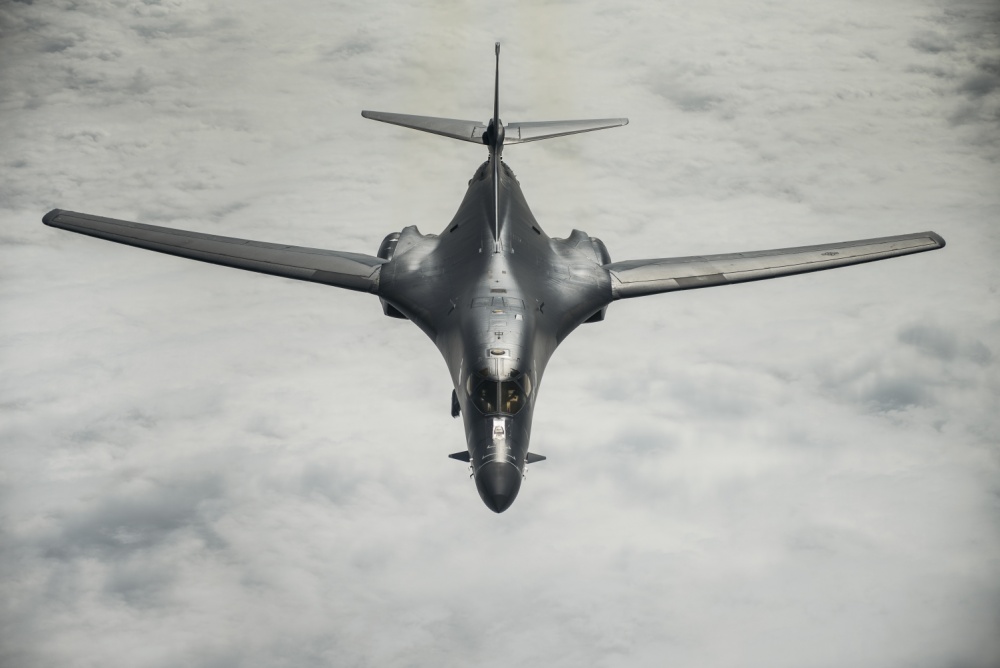
A USAF B-1B Lancer, assigned to the 37th Expeditionary Bomb Squadron, Ellsworth AFB, S.D., flies over the East China Sea, Jan. 9, 2018. Air Force photo by SSgt. Peter Reft.
The Air Force likely needs at least 225 bombers, and that means it should probably hang onto the B-1 fleet—if studies show the hard-used aircraft can hold up, Global Strike Command chief Gen. Timothy Ray said at AFA’s 2019 Air, Space & Cyber Conference.
“We have 156 bombers,” and the Air Force has determined it needs 386 combat squadrons overall “to get us to a low-risk posture,” Ray said in his speech to the AFA gathering. “Certainly that means good growth for the bomber force.”
Ray said “good research” done outside the Air Force “will tell you that the [correct] number is 225,” while the current bomber force pegs the minimum at 100 B-21s and 75 B-52s.
“Folks, that doesn’t get it if we’re really going to try to grow past 225,” Ray said.
While he did not state a need for more than 100 B-21s, Ray said reports of the B-1’s ill health may have overstated the situation, and if fatigue tests show they can last, they would be excellent standoff missile platforms.
“We’re working on the game plan; it’s not an easy one. But when I consider where we are with the B-52, the B-1, and the B-2, these are old airplanes. And so they’re not very easy to work with.”
Ray pointed out that while there are “vast resources” among US allies in airlift, fighters, ISR and other missions, only the US brings bombers to the fight.
“There are thousands of allied fighters. There’s allied fifth-gen. My point isn’t fighter versus bomber, my point is, there are no allied bombers. The last allied bomber retired in 1984.”
The US alone has bombers and ICBMs, and while there are allies with Sea-Launched Ballistic Missiles, “those are for their own personal use, their own sovereign application. There are no allied ICBMs” and “there’s no production line” for a new one yet. Likewise, though the B-21 is “doing great” it’s “years away.” The US should therefore be careful to ensure that it doesn’t shortchange the bomber and ICBM recapitalization, given their importance.
The B-1 was keeping an “incredible pace” but its “ecosystem” of support was “not healthy,” Ray acknowledged. The fleet has been grounded several times in the last year for technical problems with things such as the egress system.
Based on input from the Joint Forces Air Component commander and other leaders, Ray said GSC made the decision “to get them back home” and reset the fleet.
“We’ve been flying the plane in a way we shouldn’t have been flying it. And we did it for far too long,” he said. An Air Force official said the B-1 has been flying too many missions with wings swept forward for slow flight, as a “flying vending machine” of weapons for troops requiring support on the ground, when it was designed to fly fast at low altitudes with its wings swept back. That caused too much stress on the wings, and on their attach and sweep mechanisms.
The Air Force must complete “full scale fatigue testing” on the B-1, but “the good news is, how we’re going to operate is going to be different from what we’re doing in Iraq and Afghanistan, and we’re going to be operating like we’re assigned,” meaning doing the mission the jet was meant to do, Ray said.
Operating stand-downs of the jet have been put to good use. At Dyess AFB, Texas, Ray noted, “we had 1,400 discrepancies” on the aircraft. “We’re now down to 400, heading toward 200.” USAF now has “total confidence” in the egress systems, and the time compliance change order on the system will be finished “by the end of October, much faster than we thought.” Required depot maintenance is also “not as extensive as we thought.”
Unless certain structural issues are found to be unsolvable, Ray said, he envisions the B-1 being used once again as a fast attack airplane, carrying conventional weapons in its cavernous weapons bays. On rotary launchers, he said, the B-1 could carry “four and potentially eight large hypersonic weapons.” Exterior hardpoints that were deactivated under treaty strictures with Russia could be “opened up,” he said, and the bomber could carry JASSM-ER and LRASM stealth cruise missiles on those stations.
“So there’s a lot more we can do, and what I told the chief” is that the B-1 could be a “pretty good” system to meet USAF’s National Defense Strategy requirements, Ray said.
